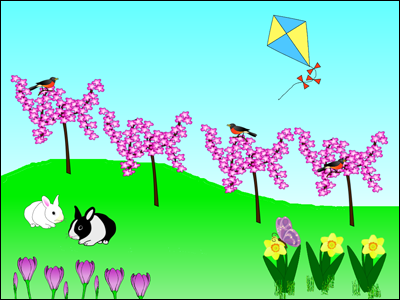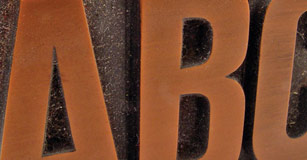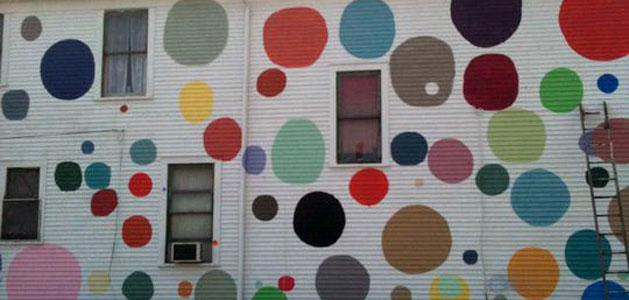Spring Into Fractions
Students will write and illustrate a spring-inspired short story including fractions they find in nature or their local community.
Applications: Pixie® or Wixie®

Task
By spring, you have likely shared several literature books with math topics. Now that you have been reading these books with students, let them know it is time for them to publish their own math stories.
Engage
Before you begin this project with your students, they should already have some familiarity with fractions. Manipulatives like oranges or paper slices of pizza are common ways to help students understand the idea of “parts of a whole.“ You could even give students squares of a chocolate bar to work with as you read The Hershey's Milk Chocolate Bar Fractions Book by Jerry Pallotta and Rob Bolster.
To introduce the project, read a story about fractions such as Full House: An Invitation to Fractions by Dale Ann Dodds. Talk to your students about the way fractions are part of the story.
Let your students know they will be creating a similar fraction story, using the spring season as the subject.
Longer days and warmer temperatures bring new activities. What are some of the activities students enjoy doing in the spring? Work together to brainstorm activities such as flying kites, using an umbrella, and watching out for new bunnies.
Next, ask your students to share the things they see in spring. Depending on where you live, the first signs of spring may be crocuses, cherry trees in bloom, the song of spring peepers, or the return of the robin. Work as a class to create of list of things they see in spring.
Choose an example or two and see how you can represent it as fractions. For example, a daffodil has six leaves; a kite may have differently colored panels.
To help students practice recognizing fractions, you can also work together to find fractions in this image or make a sample as a group.

Create
Before they begin writing, have students choose three spring objects or activities to use in their story. To help them focus on fractions, have them write a description of how each object can divided fractionally and draw a simple picture that illustrates the fraction.
You may want to set or clarify your fraction expectations. You might choose to require that students include one example of a half, third, or quarter; as well as a larger fraction, like 6/12, that is then simplified. You may also choose to let students decide which and how many fractions to include.
Have students think about their story in these three parts, with one fraction appearing in the beginning, one in the middle, and one at the end.
Fold a blank sheet of paper in half, and then fold it in half again. Open the sheet and use it as a four-pane storyboard. Have students determine a title for their story in the first pane and illustrate or describe the beginning, middle, and ending elements in the other panes.
Now that students have a visual example of each fraction and an idea of what will happen in the story, have them write a first draft. Encourage students to include clear descriptions of color, size, and shape to help readers visualize the fraction.
Have students share their stories with a partner. The partner should listen carefully and make suggestions. After sharing, students should make revisions. Have them read again, revise, and then share with you before they begin the publishing process.
Have students build their stories in Wixie. They can add text to share their writing and use the Paint tools and media library to add illustrations. Students can also use the voice recording tool to narrate each page.

This process focuses on writing and editing before working on the computer. If your students are more comfortable editing with a word processor, consider working on the rough draft on the computer. Other students may find that drawing pictures first can help them identify more accurate and descriptive words to use in their writing.
Wixie allows you to review and edit student work from your account. You can even leave comments to encourage them and give advice throughout the writing process.
Share
Once the stories are created, it is time to share. Students can easily print their stories as booklets to share with other students and to take home.
If you have iPads, or students have them at home, share student work from Wixie as an ePub. Then, email the files home so students can add them to their iBooks library.
You can also post the ePubs to a shared Dropbox or Google Drive folder making it easy to move the stories to devices in your classroom or the school media center. You can also make these folders publically accessible so other students and teachers can access and download the stories.
If you don’t have ready access to eReaders, you can export the finished work as PDF files for easy sharing. You can also link to student’s stories from your classroom web site or embed them on a blog.
Assessment
The final story and the work during the process will help you evaluate student understanding of fractions.
Their initial choice of objects for their story, along with the descriptions and illustrations, will help you identify misconceptions. Use this as a check point to determine if you need to provide further instruction on fractions with the entire class, small groups, or individuals.
The storyboard will help you identify students' ability to translate ideas into a story.
As students begin illustrating their projects, prompt them with questions that will encourage them to add more details and create more complete and specific illustrations. Each student's voice narration will give you insight into oral proficiency and reading fluency.
Resources
Pallotta, Jerry and Bolster, Rob. The Hershey’s Milk Chocolate Bar Fractions Book. ISBN: 0439135192
Dodds, Dale Ann. Full House: An Invitation to Fractions. ISBN: 0763641308
Shaskan, Trisha Speed. If You Were a Fraction. ISBN: 140484791X
Adler, David. Fraction Fun. ISBN: 0823413411
No Matter What Shape Your Fractions Are In
Standards
Common Core State Standards - Math
Number & Operations - Fractions
Develop understanding of fractions as numbers
3.NF.A.3.B Recognize and generate simple equivalent fractions, e.g., 1/2 = 2/4, 4/6 = 2/3. Explain why the fractions are equivalent, e.g., by using a visual fraction model.
3.NF.A.3.D Compare two fractions with the same numerator or the same denominator by reasoning about their size. Recognize that comparisons are valid only when the two fractions refer to the same whole. Record the results of comparisons with the symbols >, =, or <, and justify the conclusions, e.g., by using a visual fraction model.
Common Core State Standards - English Language Arts
Writing - Text Types and Purposes
3.W.3.3. Write narratives to develop real or imagined experiences or events using effective technique, descriptive details, and clear event sequences.
3.W.3.3.A. Establish a situation and introduce a narrator and/or characters; organize an event sequence that unfolds naturally.
ISTE NETS for Students 2016:
6. Creative Communicator
Students communicate clearly and express themselves creatively for a variety of purposes using the platforms, tools, styles, formats and digital media appropriate to their goals. Students:
a. choose the appropriate platforms and tools for meeting the desired objectives of their creation or communication.
b. create original works or responsibly repurpose or remix digital resources into new creations.
c. communicate complex ideas clearly and effectively by creating or using a variety of digital objects such as visualizations, models or simulations.
d. publish or present content that customizes the message and medium for their intended audiences.









